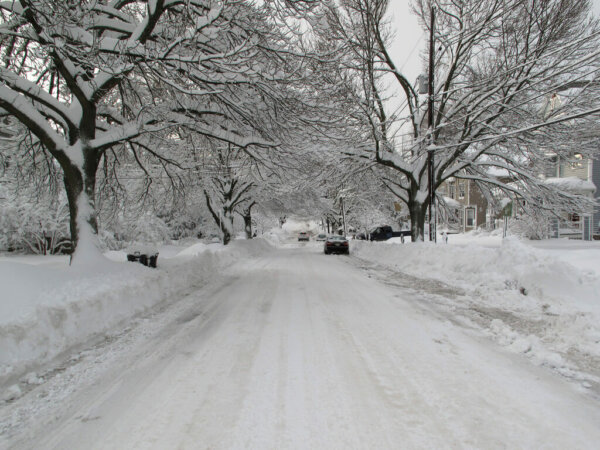Winter blizzards can be life-threatening. Are you prepared to survive winter’s wrath? Millions of people in the United States live or recreate in isolated areas, away from the amenities of city services.
If emergency services are not readily available, self-reliance is required. In an emergency scenario, your life and the life of loved ones may depend on you and you alone.
Here are some things to keep in mind for winter emergency preparedness.
Expect The Worst
The National Weather Service describes a blizzard as a massive winter storm containing significant amounts of precipitation in the form of freezing rain, sleet, snow or blowing snow with winds whipping up to more than 35 miles per hour.
One of Mother Nature’s most terrifying events, a winter blizzard, can cause power outages that last for days while making roads impassable during whiteout conditions with black ice and drifting snow.
Dangerously iced roads can limit or curtail critical community services. Transportation services, child care, health programs and schools close their doors. Public events are canceled. Businesses that are open and selling fuel and food are few and far between.
Blizzards, with heavy snow loads followed by cold temperatures, can cause water pipes to freeze and break. Even worse, heavy snow loads can cause roofs to collapse.
Injury or death may occur from slips and falls, carbon monoxide poisoning, dangerous road conditions or a cardiac episode triggered by stress or overexertion. Exposure to frigid wind chill temperatures can result in hypothermia or frostbite.
Stay Alert
Depending on where you live, winter storms can occur as early as late autumn and continue through late spring. A beautiful sunny day can turn deadly in a matter of a few hours.
Related Post: Preparing Your Homestead For Winter
Pay close attention to the weather forecast. It’s important to recognize the differences between a winter storm watch and a warning in order to be prepared and ready to take action to stay safe.
Safety Tips For Blizzards
- Keep cell phones fully charged.
- Have some cash on hand. During a severe storm, ATMs may not work, and banks will be closed.
- Know the location of your local emergency shelter.
- Ensure you have an adequate supply of required medications.
- Make sure alternative heating equipment such as space heaters, propane heaters, fireplaces and wood stoves are clean and in good repair.
- When determining if you have adequate food, heat and water to safely weather a lengthy blizzard, don’t forget the needs of your family pets.
- When venturing out dress warmly, layering clothing for insulation and warmth.
- Wear insulated, waterproof boots with a non-slip tread.
- Wear mittens instead of gloves. Your hands will stay warmer.
Traveling In Blizzards
It is imperative that you have a family communication plan in case of a blizzard or any other disaster. If you have to be on the highway, tell a relative or friend when you are leaving, your route and when you plan to arrive at your destination. Stay on major motor routes, avoiding back-road shortcuts.

Make sure vehicles are winterized and well-maintained. If you have snow tires, now is the time to put them on. If not, make sure you always carry a set of tire chains. You don’t want to break down on the side of the road in the middle of a snowstorm. Keep your fuel tank topped-off full.
Before winter winds blow, it is important to keep a storm survival kit in each family vehicle. Each kit should contain the following:
- First aid supplies
- Warm clothing
- Boots
- Winter hats and gloves
- Blankets
- A flashlight
- Extra batteries
- Waterproof matches
- Non-perishable, high-energy food items
- A metal container to melt snow
- Windshield ice scraper
- Shovel
- Water jug
- Jumper cables
- Road flares
- Signal light
- Candles
- Battery-powered radio
- Maps.
Your emergency survival kit should contain enough supplies for at least five days of self-sufficiency
Home Preparation For A Storm
To prepare for a weather emergency, confirm that you have adequate survival supplies, an emergency heating source and a fire extinguisher on hand both in the home and in the workplace. Verify that carbon monoxide and smoke detectors are in place and functioning properly in both environments.
Related Post: Disaster Preparedness For Homesteaders
If you heat your home with heating oil or wood, make sure that tanks are topped off and that you have plenty of firewood chopped and stored indoors, out of the storm.
Stockpile several gallons of bottled water. Make sure you have enough for the hydration and hygiene needs of all family members and household pets. If the power goes off, water pumps dependent on electricity will not work, or water pipes could freeze. Know where to shut off the main water valve in case pipes should burst.
Plan to check on elderly neighbors.
Protect Pets And Farm Animals
Plan to bring companion animals indoors before the storm hits. Make sure you have adequate supplies if your pets are used to eliminating outdoors. Stock up on used newspaper, paper towels and cat litter.
Provide protected shelter for livestock and horses. Grazers should have access to a sheltered food source and non-frozen water. If flooding after a storm is a potential, ensure that farm animals have unimpeded access to high ground without restriction of barriers or fences. In an emergency, you may not be able to reach them to relocate to safer pasture or paddocks.
What To Do When Stranded In A Car
If you should find yourself stranded in a snow bank, immediately check to make sure the exterior exhaust vent on your car is clear of snow to avoid carbon monoxide build-up within the vehicle. Turn the motor off.
Turn the motor on periodically to warm up, turning off again to save gas. When you do turn on the motor, first check that blowing snow has not blocked the exhaust vent.
If you are stuck on the side of the road, keep your seatbelt on and turn on your vehicle’s hazard lights. In a blinding snowstorm, a passing motorist, unable to see you, could collide with your vehicle. Set off roadside flares near the vehicle, alerting other drivers and potential rescuers of your location.
If you’re traveling with a group, avoid dispatching a person to seek help. It is far too dangerous. Venturing out in the height of the storm is extremely risky and increases mortality as visibility likely hovers close to zero and temperature and wind activity are unpredictable.
When the north wind blows and temperatures drop, it is especially important to stay hydrated. Dehydration is one of the most dangerous elements in a survival situation. Dehydration confuses, resulting in poor decisions, and if dehydrated, you are more likely to experience frostbite and hypothermia.
Avoid eating snow, as it will substantially lower the temperature of your body core. Instead, melt snow in a container in front of your car’s heating vent. As an alternative, place snow in a waterproof container and then place between layers of clothing on your core. Your body heat will melt the snow to liquid.
If you have food available in your vehicle, rationing it will help make supplies last. The storm could go on for days. Do not consume large meals.
Shelter In Place
If you are camping or driving when heavy snow starts to pile up and it is evident that you are stranded on the roadside or marooned at your campsites, your safest option is to stay put and shelter in place. Hunker down and ride out the fury.
If you find yourself outside, without a tent or a car, immediately seek shelter in a cave, overhang or fashion available materials into a protective shelter. If shelter is unavailable, craft a snow cave as insulation from the bitter cold.
After The Storm
Your physical state after the storm passes and the sun comes out will determine what comes next. If you are fit enough to dig out, do so. If physical effort seems impossible, wait for assistance. Be confident that help will arrive. A great many persons have survived for a week or more waiting for rescue, trapped in their car. Just sit tight.
References
- Snowstorms And Extreme Cold, Ready
- Winter Safety, Red Cross
- How To Prepare For A Winter Storm, FEMA
- Winter Storm Safety Tips, National Weather Service









































Leave a Reply